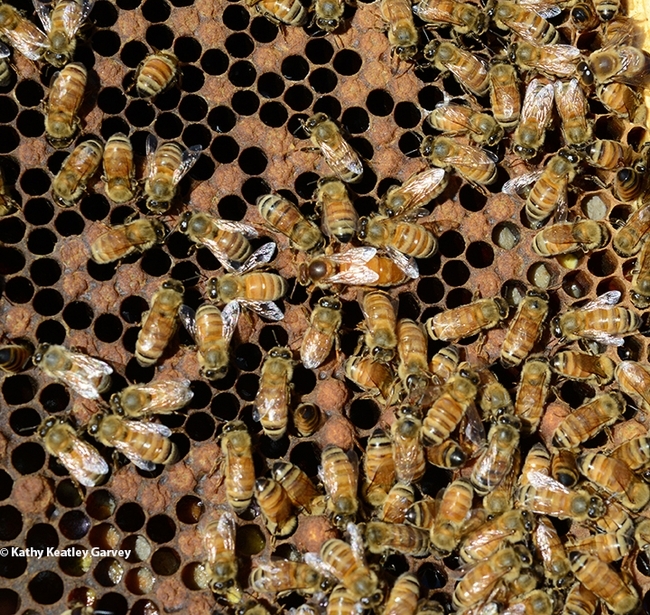- Author: Kathy Keatley Garvey
It was a good day for a praying mantis.
It was not a good day for a honey bee.
Here's what happened in the "Daily Insect News": a gravid praying mantis, Stagmomantis limbata, ambushed and ate a honey bee on a Mexican sunflower, Tithonia rotundifola, in a Vacaville pollinator garden.
In this image, of a mantis snacking on a bee, do you know which one is a native of the United States and which two are not?
The plant? It's a non-native. It's native to Mexico and Central America.
The honey bee? It's a non-native. European colonists brought the honey bee (Apis mellifera) to what is now the United States in 1622. Specifically, they arrived at the Jamestown colony (Virginia). Factoid: The Native Americans called the honey bee "the white man's fly." Another factoid: California had no honey bees until 1853 when a beekeeper brought his colonies to the San Jose area.
And the praying mantis, Stagmomantis limbata? It's considered native to North America, particularly prevalent in the southwestern United States. Commonly known as "bordered mantis, "bosque mantis," "Arizona mantis" or "New Mexico praying mantis," it is green or light brown and can reach three inches in length, according to Wikipedia.
We've seen mantids snag not only honey bees, but monarchs, Western tiger swallowtails, Gulf Fritillaries, skippers, syrphid flies and long-horned bees.
Never once--not once--have we seen this species grab and dine on a stink bug, milkweed bug or lygus bug.
Maybe a little menu planning is in order, Ms. Mantis? Maybe you should check out the UC Statewide Integrated Pest Management Program site to determine which is a pest and which is a beneficial insect?
Nah, just kidding...everything in the garden must eat to survive.
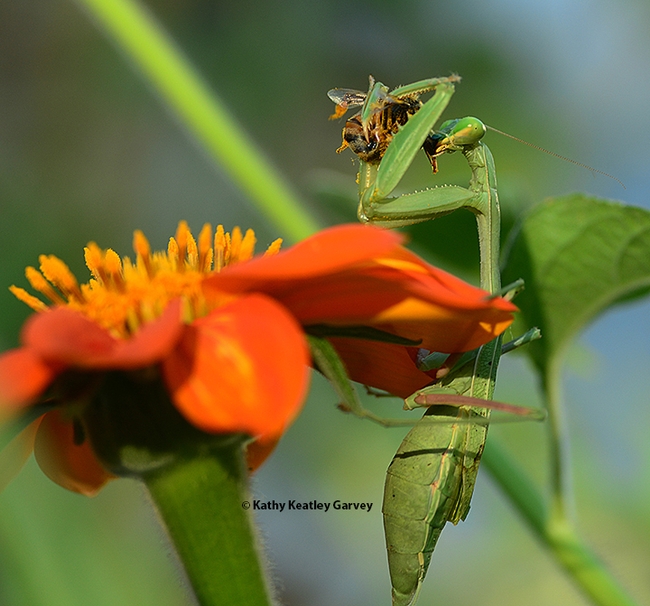
- Author: Kathy Keatley Garvey
Have you ever seen a freeloader fly trying to sneak a meal?
Since it's Friday Fly Day--and the best things in life are free, aren't they?--it's time to post an image of a freeloader fly.
So here's the story: a praying mantis was polishing off the remains of a honey bee, and uninvited dinner guests--freeloader flies (family Milichiidae, probably genus Desmometopa)--showed up. This genus includes more than 50 described species, according to Wikipedia.
Another time, a spider snagged a honey bee, and freeloaders arrived just in time to chow down. "Call me anything you like but don't call me late to dinner." They bring nothing to contribute to the meal except their appetites.
So did the predators chase away the freeloader flies? No. Absolutely not. Apparently they're too tiny a morsel to eat, and the freeloaders don't eat much. (See BugGuide.net's images of them.
Happy Friday Fly Day!
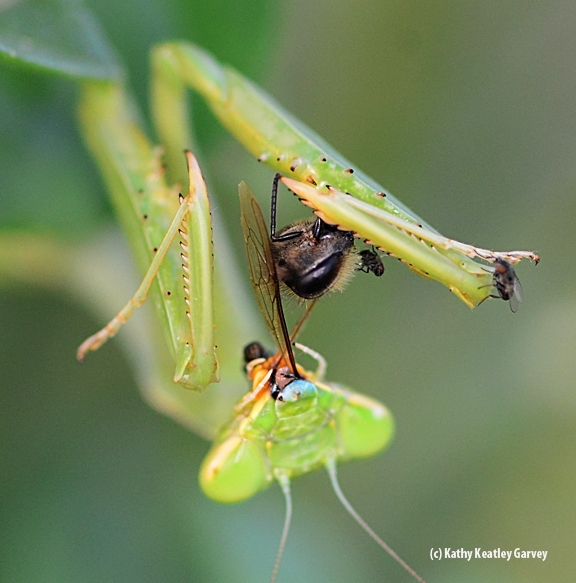
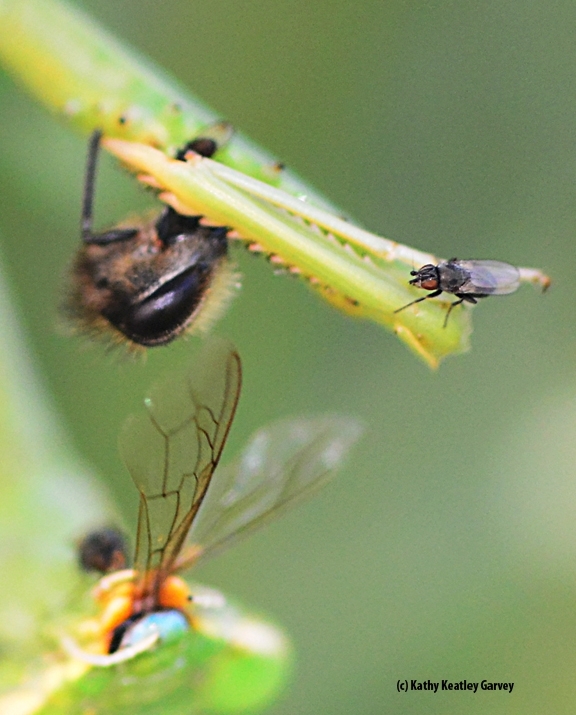
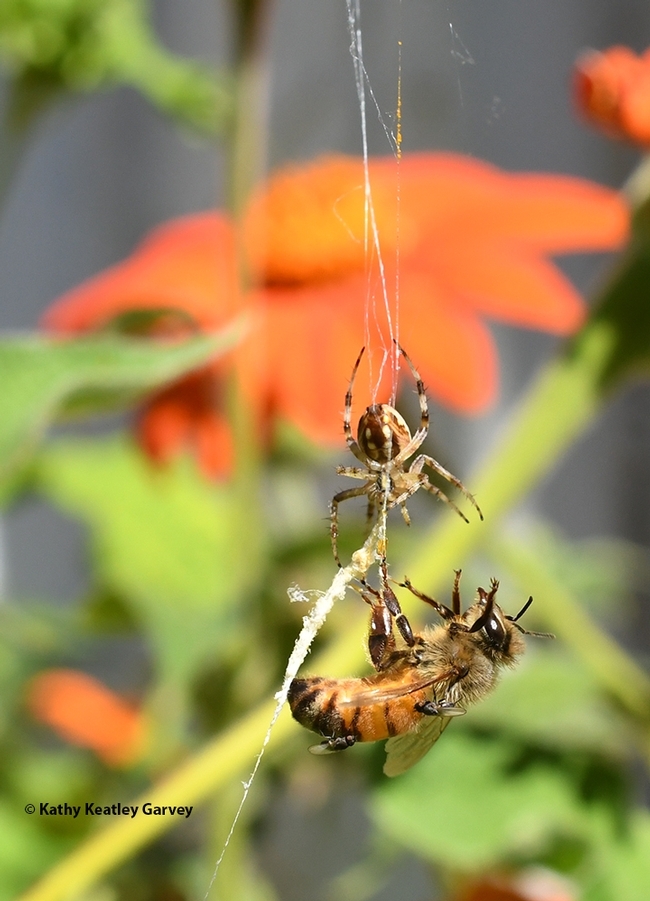
- Author: Kathy Keatley Garvey
Oh, the patience of a crab spider.
It lies in wait on the Mexican sunflower, Tithonia rotundifola, in the hot sun.
It scuttles back and forth, extending its legs. It's an ambush predator, ready to inject venom.
But it seems as if all the bees got the memo: "Crab spider! Beware! Don't buzz it! Don't go near it!"
And then a honey bee, seeking a little nectar and pollen, lands right beside it.
It's a moment in time between a predator and its prey.
The bee? It survived to live another day. The crab spider went hungry.
Just a morning in the life of a crab spider lying in wait on a Tithonia rotundifola.
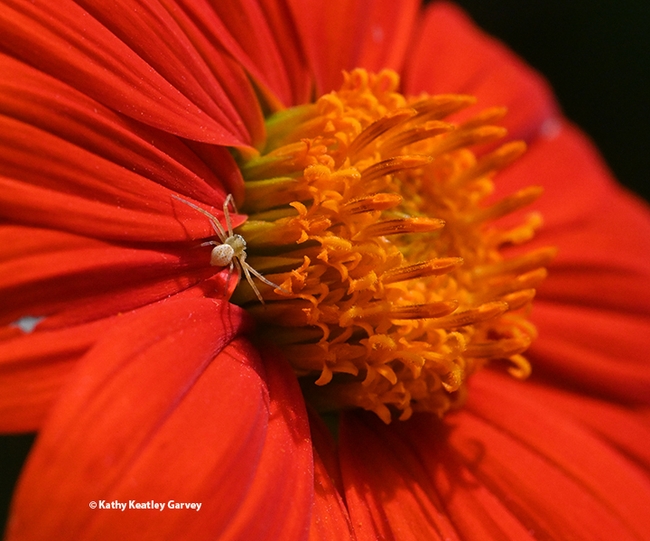
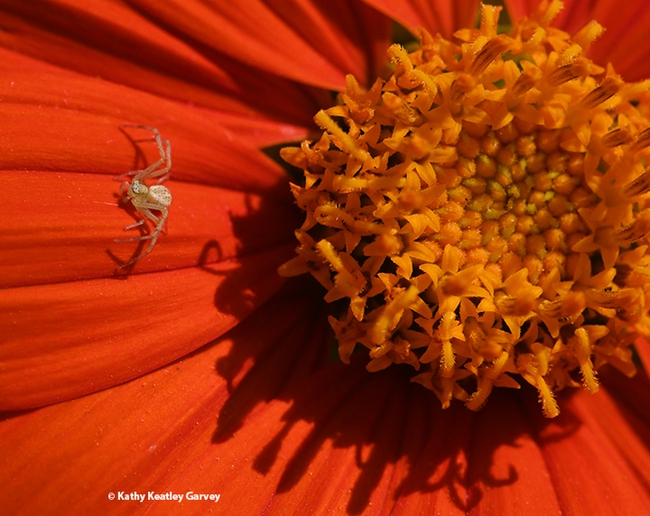
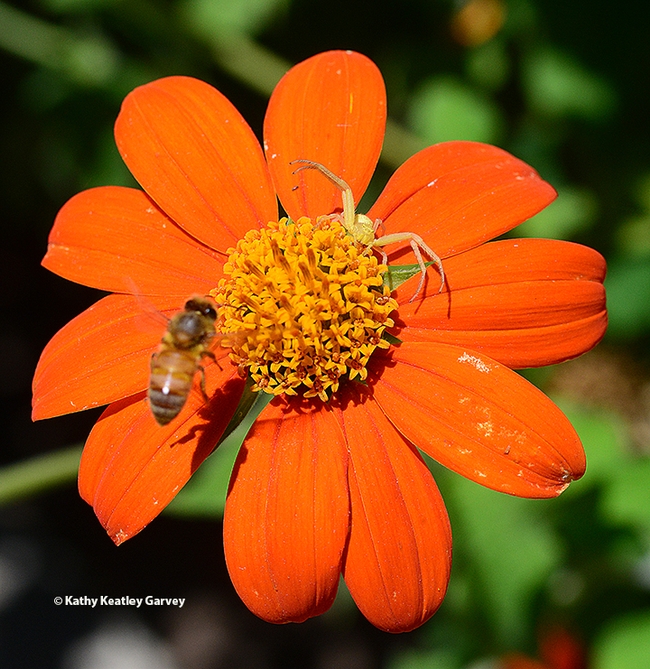
- Author: Kathy Keatley Garvey
A sneak peak at a couple of Solano County Fair entries...think insects!
The COVID-19 pandemic derailed fairs and festivals, but now they're back on track.
Take the 73rd annual Solano County Fair, themed "Bales of Fun." Located at 900 Fairgrounds Drive, Vallejo, it opens June Thursday through Sunday, June 16-19, and gate admission is free. Headed by president Lee Williams of Rio Vista, the board of directors includes Valerie Williams of Vacaville, better known as "Mrs. Solano County 4-H." In fact, Valerie has served tirelessly for some 25 years as the Solano County 4-H program representative. The 4-H program is part of the University of California's Agriculture and Natural Resources or UC ANR.
Our favorite part of the fair? The exhibits at McCormack Hall, particularly those that are insect-themed.
One entry, by talented photographer Matthew Agbayani, 17, of the Vaca Valley 4-H Club, Vacaville, shows a syrphid fly and a honey bee sharing a sunflower. It takes a special kind of patience to be able to capture two species on the same flower.
Many folks mistake syrphid flies, aka hover flies or hover flies, for honey bees. They're both pollinators.
Three of the easiest ways to differentiate a fly from a bee:
- A fly has one set of wings. A bee has two sets.
- A fly has short, stubby antennae. A honey bee doesn't.
- A fly has no corbicula or pollen basket. A honey bee (worker bee) does.
Among the other insect-themed displays: Rio Vista resident Richard Laswell's exquisite watercolor depicting three dragonflies that he entered in the amateur art division; and Vallejo resident Ashley Workman's colorful blue butterfly (oils and acrylics) that she entered in open art division.
Art by Iris Mayhew of American Canyon also caught our eye. She drew inspiration from a safari in Kenya. "I love animals," she said. That includes monarchs and Gulf Fritillaries. She'll be depicting them next.
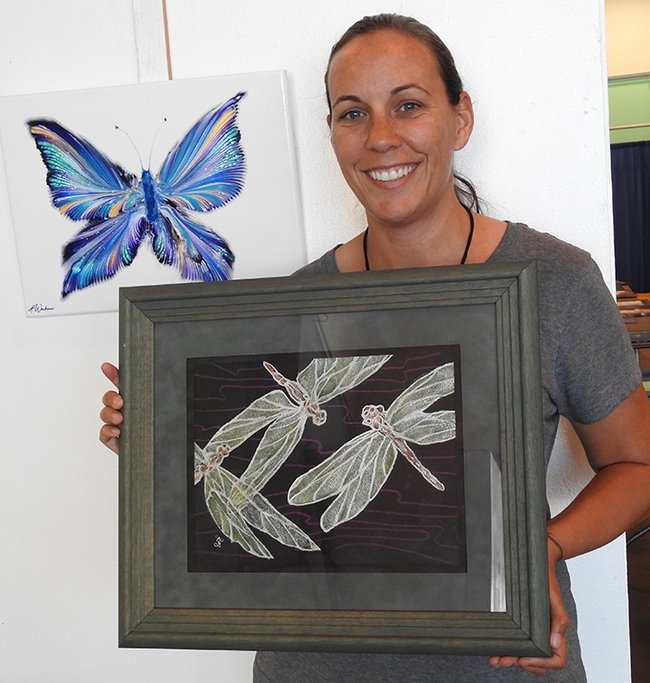
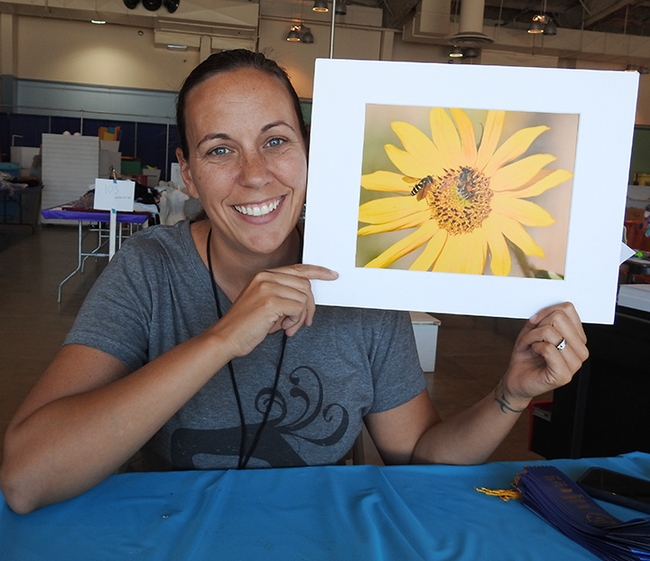

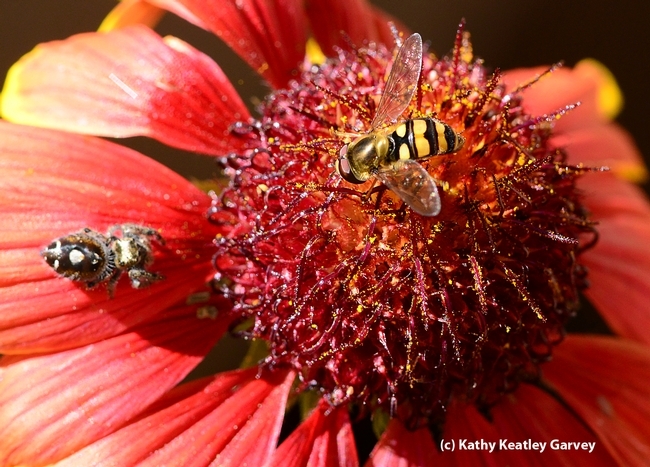
- Author: Kathy Keatley Garvey
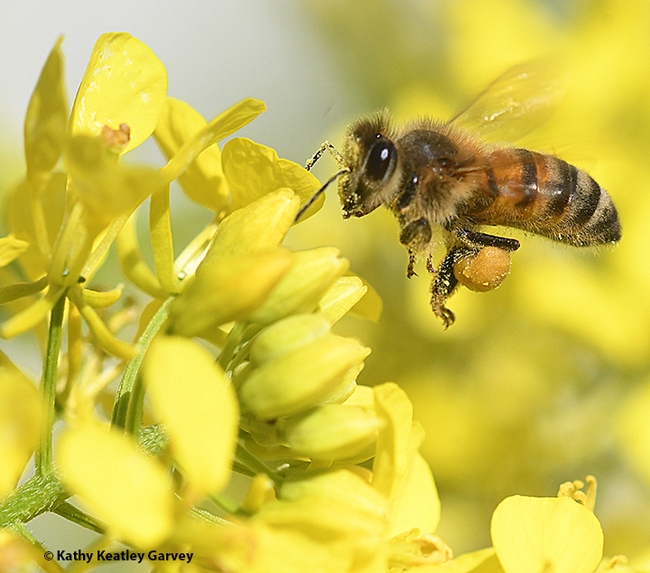
We know that European colonists introduced honey bees (Apis mellifera) into the Jamestown colony (now Virginia) in 1622.
But where did the Western honey bee originate? Scientists at York University, a public research university in Toronto, Ontario, Canada, recently discovered that it originated in Asia. Genetics told them so.
The abstract of the paper, "Thrice Out of Asia and the Adaptive Radiation of the Western Honey Bee," published in Science:
"The origin of the western honey bee Apis mellifera has been intensely debated. Addressing this knowledge gap is essential for understanding the evolution and genetics of one of the world's most important pollinators. By analyzing 251 genomes from 18 native subspecies, we found support for an Asian origin of honey bees with at least three expansions leading to African and European lineages. The adaptive radiation of honey bees involved selection on a few genomic 'hotspots.' We found 145 genes with independent signatures of selection across all bee lineages, and these genes were highly associated with worker traits. Our results indicate that a core set of genes associated with worker and colony traits facilitated the adaptive radiation of honey bees across their vast distribution."
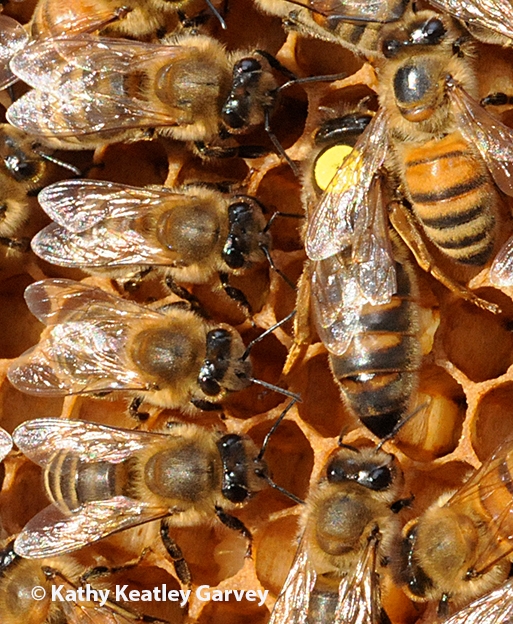
York University doctoral student Kathleen Dogantzis of the Faculty of Science led the research team. "Our research suggests that a core-set of genes allowed the honey bee to adapt to a diverse set of environmental conditions across its native range by regulating worker and colony behaviour," Dogantzis says in a Phys.Org article.
Why is it important to know the origin? To understand its evolution, its genetics and its adaptation and how this can relate to the current population of bees and to modern-day beekeeping.
Or, as they wrote in their scientific paper: "Resolving the ancestral origin and evolutionary expansion of A. mellifera will enhance our ability to identify derived and ancestral genetic mutations. This is especially relevant for tracing the evolution of derived phenotypes and for discerning how locally adapted subspecies may contribute to the fitness and diversity of managed colonies."
"In conclusion," they wrote, "we have presented compelling evidence that A. mellifera emerged in Asia with the remainder of extant honey bees but then expanded into its current distribution via Western Asia. This expansion event is marked by at least three independent colonization routes that gave rise to seven genetically distinct lineages. Modern populations of A. mellifera maintain high genetic diversity, which has allowed the species to adapt to diverse environments through repeated selection among a common set of genes. These genes are often related to worker phenotypes, supporting that the worker caste is key to the adaptative radiation of the species."
Jamestown Colony. The first honey bees to arrive in what is now the United States were what beekeepers call the "dark bee" subspecies of Northern Europe, Apis mellifera mellifera. Today the Italian bee, Apis mellifera ligustica is the most common bee the United States.
The Italian bee didn't arrive in America until 1859. "The American beekeeping public was enamored with the newly available yellow and gentle bees," bee breeder-geneticist and co-author Susan Cobey of Washington State University (formerly of UC Davis) wrote in a chapter of the book, Honey Bee Colony Health: Challenges and Sustainable Solutions. "As a result, Italian-type bees form the basis for most present-day commercial beekeeping stocks in the U.S. Following the arrival and success of honey bees from Italy, U.S. beekeepers developed an interest to try other honey bee subspecies." Cobey studied with Harry H. Laidlaw Jr. (1907-2003) of UC Davis, the "father of honey bee genetics" and for whom the university's bee biology facility is named.
And speaking of the introduction of honey bees into the United States, it took 231 for years for honey bees to arrive in California. Beekeeper Christopher A. Shelton introduced honey bees to the Golden State in 1853, establishing an apiary just north of San Jose. (Check out the bee plaque at the San Jose International Airport.)
Now we know that our beloved Western honey bee originated in Asia.
